Inventory management is one major factor in running a successful ecommerce business. Efficiently managing inventory can lead to improved customer satisfaction, increased sales, and reduced costs. According to Aberdeen Group study, companies with effective inventory management practices achieved an average 10% reduction in carrying costs and a 98% inventory accuracy rate. In this blog post, know the top 7 effective ecommerce inventory management techniques that boost your business to optimize its inventory system.
What Is Inventory Management in Ecommerce

Inventory management in ecommerce refers to the process of overseeing and controlling the flow of goods within an online retail business. It involves tracking, organizing, and optimizing inventory levels to meet customer demand while minimizing costs and operational inefficiencies. Effective inventory management ensures that products are available when customers need them, reduces the risk of stockouts, prevents overstocking, and ultimately leads to improved profitability.
Types of Inventory that Ecommerce Business Needs to Manage

a) Raw Materials: These are the basic components or materials used to produce the final products. Ecommerce businesses need to keep track of their raw material inventory to ensure a smooth production process.
b) Finished Goods: These are the end products ready for sale. Ecommerce businesses must maintain appropriate levels of finished goods inventory to fulfill customer orders promptly.
c) Work in Progress (WIP): WIP inventory includes partially completed products that are still undergoing manufacturing or assembly processes. Managing WIP inventory is crucial for ecommerce businesses to maintain production efficiency and meet customer demands.
d) Safety Stock: This is extra inventory held to protect against unexpected fluctuations in demand or supply chain disruptions. It acts as a buffer to prevent stockouts and ensure continuous order fulfillment.
5 Benefits of Efficient Ecommerce Inventory Management
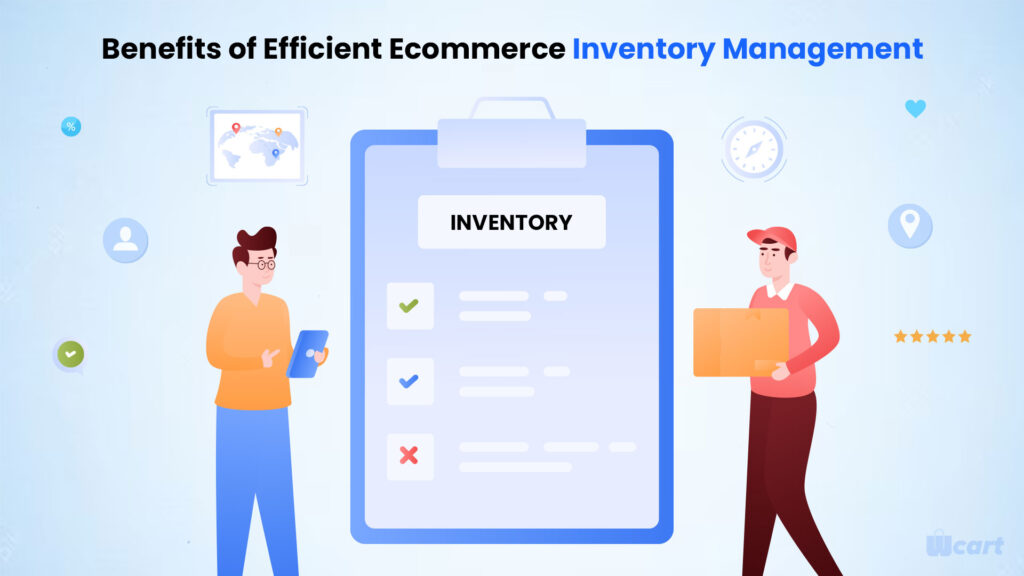
a) Improved Customer Satisfaction: By ensuring products are readily available for purchase, businesses can meet customer demand and avoid stockouts. This leads to enhanced customer satisfaction and loyalty.
b) Cost Savings: Optimizing inventory levels helps minimize costs associated with excess stock and storage. Businesses can free up capital tied up in inventory and allocate resources more effectively.
c) Better Decision Making: Accurate inventory data allows businesses to make informed decisions about purchasing, pricing, and promotions. Data-driven insights enable strategic planning and help identify areas for improvement.
d) Streamlined Operations: Effective inventory management streamlines order fulfillment processes, reduces manual errors, and improves operational efficiency. This results in faster order processing, reduced lead times, and enhanced productivity.
e) Competitive Advantage: Businesses that effectively manage their inventory gain a competitive edge. They can fulfill orders faster, offer a wider product selection, and provide superior customer service, leading to increased market share.
4 Common Key Challenges in Managing Inventory for Online Businesses
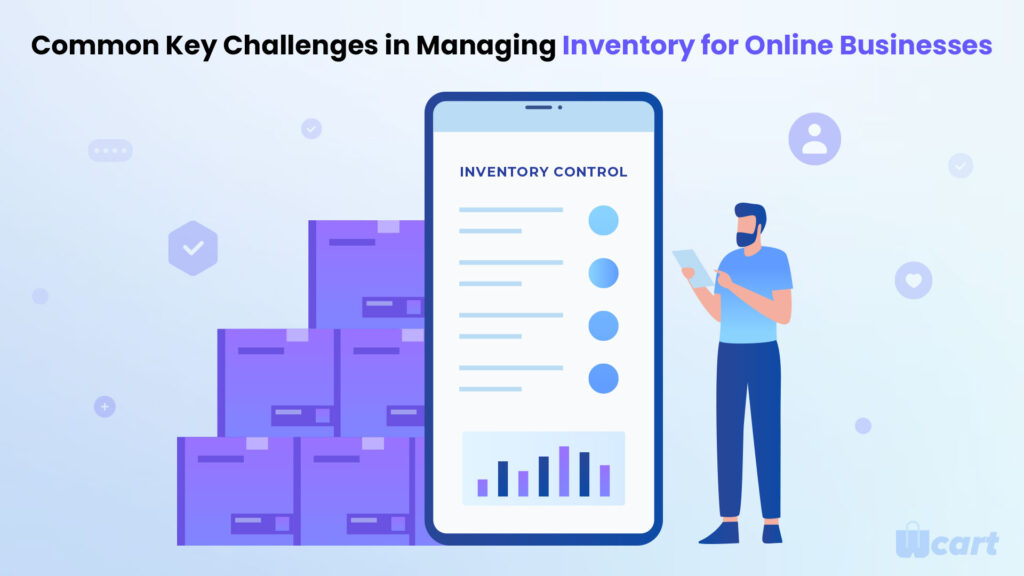
Managing inventory in ecommerce comes with its own set of challenges. Here are some:
a) Demand Forecasting: Accurately predicting customer demand is essential for maintaining optimal inventory levels. Ecommerce businesses need to analyze historical data, market trends, and customer behavior to forecast demand accurately.
b) Inventory Visibility: With multiple sales channels and warehouses, maintaining real-time visibility of inventory becomes crucial. Ecommerce businesses must have systems in place to track inventory levels across various locations accurately.
c) Order Fulfillment: Efficiently processing and fulfilling orders in a timely manner is a challenge for ecommerce businesses. Meanwhile, coordinating inventory availability, picking, packing, and shipping processes require streamlined workflows and effective inventory management practices.
d) Inventory Holding Costs: Inventory carrying costs, such as storage, insurance, and depreciation, can significantly impact a business’s profitability. Optimizing inventory turnover and minimizing holding costs are essential for financial success.
Visit Here: To Know Importance of a Smooth Payment System in Ecommerce
Top 7 Essential Techniques for Effective Inventory Management

Certainly, effective inventory management is most important for the success of ecommerce businesses. By employing essential techniques, businesses can optimize inventory levels, meet customer demand, and minimize costs. Some of them are listed below:
1. Accurate Demand Forecasting

correspondingly, it involves predicting future customer demand based on historical data, market trends, and other relevant factors. As soon as, by understanding customer preferences, seasonal variations, and market dynamics, businesses can make informed decisions regarding inventory levels, purchasing, and production planning.
Reasons Why Demand Forecasting in Ecommerce is Important
Demand forecasting plays a vital role in ecommerce inventory management for several reasons:
a) Optimizing Inventory Levels: Helps businesses maintain optimal inventory levels. By predicting future demand, businesses can avoid overstocking or stockouts, ensuring that the right amount of inventory is available to meet customer needs.
b) Cost Reduction: Minimizes costs associated with excess inventory and storage. It allows businesses to allocate resources efficiently, reducing holding costs and maximizing profitability.
c) Enhanced Customer Satisfaction: Businesses can ensure product availability, leading to improved customer satisfaction. Customers can find the products they want in stock, which enhances their shopping experience and increases the likelihood of repeat purchases.
Visit Here: 12 Must-Try Tips for Increasing Ecommerce Conversion Rates
Methods and Tools for Demand Forecasting
Various methods and tools are available to facilitate demand forecasting in ecommerce:
a) Historical Data Analysis: Analyzing past sales data helps identify patterns, trends, and seasonality in customer demand. Statistical techniques such as moving averages, exponential smoothing, and regression analysis can be used to forecast future demand based on historical patterns.
b) Market Research and Surveys: By the time, conducting market research and surveys can provide insights into customer preferences, buying behavior, and anticipated demand for specific products. These qualitative methods supplement quantitative analysis and help refine demand forecasts.
c) Demand Planning Software: Specialized software tools and platforms are available to streamline demand forecasting processes. Likewise, these tools incorporate historical data, market trends, and statistical algorithms to generate accurate demand forecasts.
Best Practices for Accurate Demand Forecasting
Businesses should consider the following best practices to ensure accurate demand forecasting in ecommerce:
a) Use Multiple Data Sources: Incorporate various data sources, such as sales data, website analytics, market research, and customer feedback, to gain a comprehensive understanding of demand drivers.
b) Regularly Update Forecasts: Demand patterns can change over time due to market dynamics, customer behavior, and external factors. It’s equally important to review and update demand forecasts regularly to reflect these changes accurately.
c) Collaborate with Stakeholders: Meanwhile engage with different departments, including marketing, sales, and supply chain, to gather insights and validate demand forecasts. Collaboration fosters a more holistic and accurate forecasting process.
d) Monitor and Adjust: Continuously monitor demand patterns, inventory levels, and actual sales performance. Compare actual sales with forecasted demand to identify any discrepancies and adjust forecasting models accordingly.
e) Continuous Improvement: Demand forecasting is an iterative process. Analyze forecasting accuracy, identify areas for improvement, and refine forecasting techniques over time to achieve better results.
2. Inventory Tracking and Monitoring

It involve keeping a close eye on stock levels, product movement, and inventory-related data. By implementing robust tracking systems and processes, ecommerce businesses can gain real-time visibility into their inventory. Consequently, this enables efficient order fulfillment, prevents stockouts, and reduces excess inventory. As a result, regular monitoring helps identify trends, optimize inventory levels, and make data-driven decisions.
Reasons Why Real-Time Inventory Tracking Are Important
Real-time inventory tracking is most important for ecommerce businesses. It provides up-to-date information on stock levels, allowing businesses to fulfill orders accurately and promptly. Real-time tracking helps correspondingly to prevent overselling or underselling, leading to improved customer satisfaction. It also enables proactive inventory management by identifying low-stock situations, triggering reorder points, and ensuring inventory accuracy across multiple sales channels.
Inventory Management Systems and Software
Inventory management systems and software simplify and streamline inventory-related tasks. These tools offer features such as inventory tracking, demand forecasting, order management, and reporting. Firstly, by leveraging inventory management software, ecommerce businesses can centralize their inventory data, automate processes, and gain actionable insights. Meanwhile, it leads to improved efficiency, reduced errors, and better inventory control.
Implementing Effective Inventory Monitoring Processes
To implement effective inventory monitoring processes, ecommerce businesses can follow these steps:
a) Set Key Performance Indicators (KPIs): Define KPIs that align with inventory management goals, such as inventory turnover, stockout rate, and fill rate. These metrics help monitor inventory performance and identify areas for improvement.
b) Regularly Conduct Cycle Counts: Conduct regular physical inventory counts to reconcile actual stock levels with recorded data. Cycle counting ensures inventory accuracy and helps identify discrepancies or issues promptly.
c) Utilize Automated Alerts: Implement automated alerts for low-stock levels, stock discrepancies, or unusual inventory movements. Alerts enable timely actions and minimize the risk of stockouts or overstocking.
d) Analyze Inventory Reports: Regularly review inventory reports to identify trends, analyze demand patterns, and optimize inventory levels. Utilize reports to make data-driven decisions, improve forecasting accuracy, and streamline operations.
e) Continuously Improve Processes: Regularly evaluate inventory monitoring processes, identify bottlenecks, and implement improvements. Embrace technologies, such as barcode scanning or RFID systems, to enhance accuracy and efficiency.
Visit Here: Design an Online Store with User Friendly and SEO Friendly
3. ABC Analysis and SKU Classification

ABC analysis is a technique used in inventory management to classify items based on their value and importance. SKU (Stock Keeping Unit) classification refers to categorizing products based on specific attributes such as demand, profitability, or sales volume. At the same time, by combining ABC analysis and SKU classification, ecommerce businesses can effectively prioritize their inventory management efforts.
Reasons Why ABC Analysis and Its Relevance in Ecommerce Are Important
ABC analysis involves dividing items into three categories: A, B, and C, based on their relative value. Category A represents high-value items that contribute to a significant portion of revenue, while Category C includes low-value items with lower sales volume. Being that in ecommerce, where there are often numerous SKUs, ABC analysis helps businesses focus on managing high-value items more closely and allocate resources efficiently.
Strategies for Classifying SKUs Based on Value and Demand
To classify SKUs effectively, ecommerce businesses can consider the following strategies:
a) Revenue or Sales Volume: Classify SKUs based on their contribution to overall revenue or sales volume. High-revenue SKUs can be assigned to Category A, while low-revenue SKUs can fall into Category C.
b) Profitability: Analyze the profitability of SKUs by considering factors such as production costs, overhead expenses, and margins. Given that this approach helps to identify high-profit items for Category A classification.
c) Demand Patterns: Classify SKUs based on their demand patterns, such as fast-moving items or slow-moving items. High-demand products can be assigned to Category A, while low-demand products can be categorized as Category C.
Optimizing Inventory Levels Based on SKU Classification
Once SKUs are classified, ecommerce businesses can optimize their inventory levels accordingly:
a) Category A: Focus on maintaining adequate inventory levels for high-value items with high demand. Implement tight inventory control, frequent replenishment, and close monitoring to prevent stockouts.
b) Category B: Moderate-value items with moderate demand can be managed with a balanced approach. Maintain sufficient stock levels to meet customer demand without excessive inventory holding costs.
c) Category C: Low-value items with low demand can be managed with minimal inventory levels. Consider on-demand or just-in-time ordering for these items to reduce storage costs and the risk of obsolescence.
4. Just-in-Time (JIT) Inventory Management
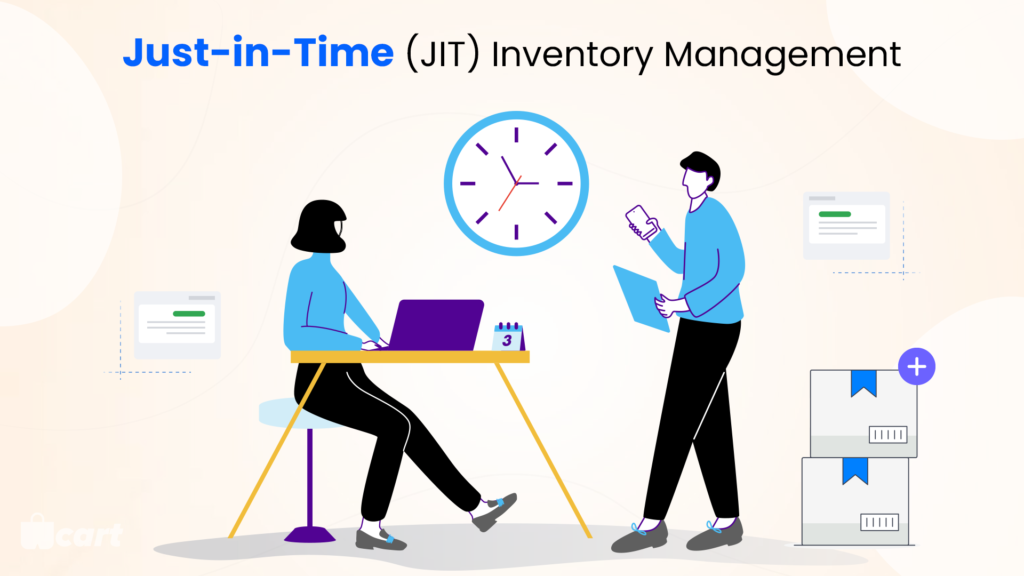
Just-in-Time (JIT) inventory management is an approach that aims to minimize inventory levels by receiving or producing goods just in time for their use or sale. Particularly, in the context of ecommerce, JIT inventory management focuses on maintaining lean inventory levels to reduce costs, improve efficiency, and enhance customer satisfaction.
JIT Inventory Management Approach Explained
In brief, JIT inventory management operates on the principle of having the right amount of inventory available at the right time. Instead of keeping excess inventory, businesses order or produce goods based on actual demand. In conclusion, by synchronizing the supply chain with customer demand, JIT inventory management minimizes holding costs, reduces waste, and optimizes cash flow.
Advantages and Challenges of Implementing JIT in Ecommerce
Implementing JIT inventory management in ecommerce offers several advantages:
a) Cost Reduction: JIT eliminates the need for excess inventory, reducing storage costs, and minimizing the risk of inventory obsolescence. It also reduces the need for large warehouse spaces, leading to cost savings.
b) Increased Efficiency: JIT streamlines inventory processes, enabling faster order fulfillment and reducing lead times. This improves overall operational efficiency and allows businesses to respond quickly to changing customer demand.
c) Enhanced Cash Flow: To begin with JIT, businesses invest less capital in inventory, freeing up cash for other business needs. This can improve liquidity and support business growth.
Despite its advantages, implementing JIT in ecommerce comes with some challenges:
a) Demand Variability: Ecommerce businesses often face unpredictable demand patterns, which can make JIT implementation challenging. Fluctuating customer demand may require flexibility in inventory management strategies.
b) Supplier Reliability: JIT relies on timely deliveries from suppliers. If suppliers fail to deliver goods on time, it can disrupt operations and lead to stockouts.
c) Technology and Systems: In the meantime, implementing JIT effectively requires robust inventory management systems, accurate demand forecasting, and seamless coordination with suppliers. Businesses need to invest in appropriate technology and ensure system compatibility.
Steps to Successfully Adopt JIT Inventory Management
To successfully adopt JIT inventory management in ecommerce, businesses can follow these steps:
a) Analyze Demand Patterns: Thoroughly analyze customer demand patterns, considering factors such as seasonality, trends, and product life cycles. Accurate demand forecasting is crucial for JIT implementation.
b) Strengthen Supplier Relationships: Establish strong relationships with reliable suppliers who can meet JIT requirements. Collaborate closely with suppliers to ensure timely deliveries and maintain open communication channels.
c) Embrace Automation: Leverage inventory management software and automation tools to streamline processes and gain real-time visibility into inventory levels. Automation helps synchronize inventory information across multiple sales channels and ensures accurate data for JIT decision-making.
d) Implement Continuous Improvement: Continuously monitor and evaluate inventory management processes. Identify areas for improvement, such as reducing lead times, eliminating waste, and optimizing order fulfillment processes.
e) Train and Educate Staff: Educate employees about the principles and benefits of JIT inventory management. Provide training on new processes, technology, and the importance of accurate demand forecasting.
Visit Here: 5 Must-Have Features to Look for in an Ecommerce Builder
5. Safety Stock and Reorder Point Optimization
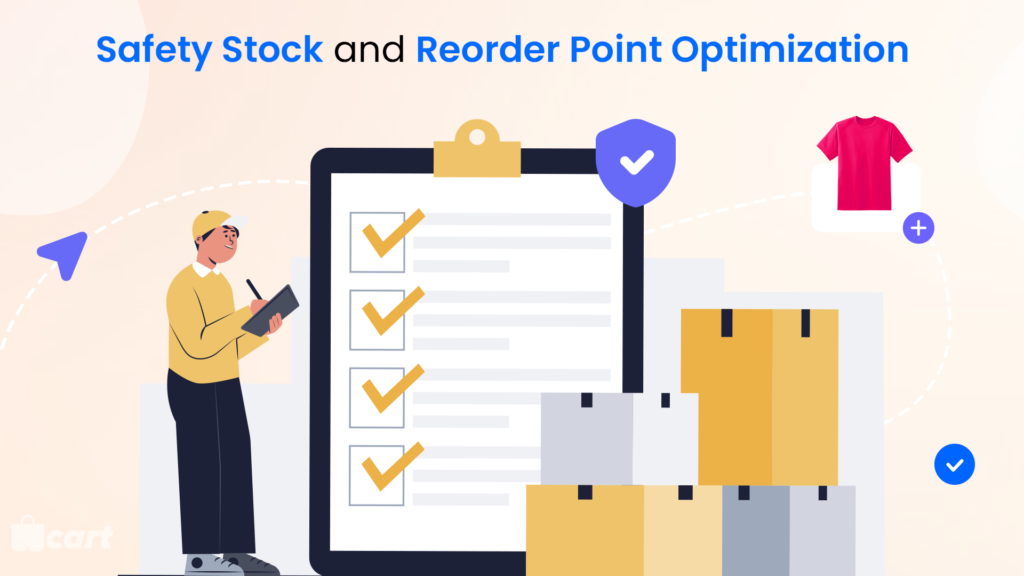
These are critical aspects of inventory management in ecommerce. Safety stock acts as a buffer to ensure that there is sufficient inventory to meet unexpected spikes in demand or delays in supply. Reorder point is the inventory level at which new orders should be placed to replenish stock. Optimizing safety stock and reorder points helps businesses maintain adequate inventory levels while minimizing costs and the risk of stockouts.
Reasons Why Safety Stock and Reorder Points Are Important
Safety stock and reorder points play crucial roles in inventory management:
a) Safety Stock: Having safety stock mitigates the risk of stockouts due to unexpected increases in demand or supply chain disruptions. It ensures that businesses can continue fulfilling orders without delays, enhancing customer satisfaction.
b) Reorder Points: Establishing accurate reorder points helps businesses avoid stockouts and excessive inventory. By replenishing inventory at the right time, ecommerce businesses can optimize cash flow, reduce carrying costs, and improve operational efficiency.
Calculating Safety Stock and Reorder Points
To calculate safety stock and reorder points, businesses can consider factors such as historical demand, lead time, and desired service level. Various mathematical formulas and statistical methods, such as standard deviation and lead time demand, can be used to determine the appropriate levels.
Strategies for Optimizing Safety Stock Levels
To optimize safety stock levels, ecommerce businesses can employ the following strategies:
a) Accurate Demand Forecasting: Improving demand forecasting accuracy helps determine the right amount of safety stock required. Leveraging historical sales data, market trends, and customer insights enables better estimation of future demand.
b) Service Level Analysis: Analyze customer expectations and service level agreements to set appropriate safety stock levels. Balancing customer satisfaction and inventory costs is crucial in determining the optimal service level.
c) Collaborative Relationships with Suppliers: Establishing collaborative partnerships with suppliers can help reduce lead times and increase reliability. Close collaboration enables better coordination, minimizing the need for excessive safety stock.
6. Efficient Order Fulfillment and Warehouse Management

Efficient order fulfillment and warehouse management are key to successful inventory management in ecommerce:
a) Streamlining Order Fulfillment Processes: Streamlined order fulfillment processes reduce lead times, improve order accuracy, and enhance customer satisfaction. Utilize technology, automation, and efficient order picking strategies to expedite the fulfillment process.
b) Warehouse Organization and Layout Optimization: Efficient warehouse organization ensures easy access to inventory, reduces picking errors, and maximizes storage capacity. Optimize layout, implement proper labeling and slotting techniques, and use inventory management software for better warehouse organization.
c) Automating Warehouse Operations for Efficiency: Embrace automation technologies such as barcode scanning, RFID systems, and automated picking systems to improve accuracy, speed, and efficiency in warehouse operations. Automation reduces manual errors and enhances overall productivity.
7. Supplier Relationship Management

Strong supplier relationships contribute to effective inventory management:
a) Establishing Strong Relationships with Suppliers: Build strong relationships with reliable suppliers who can meet demand consistently. Open communication, trust, and mutual collaboration are key elements of successful supplier relationships.
b) Negotiating Favorable Terms and Agreements: Negotiate favorable terms, such as lead times, pricing, and payment terms, to optimize inventory management. Flexibility in supplier agreements can help businesses adjust to changing market dynamics and demand patterns.
c) Collaborative Planning with Suppliers for Better Inventory Management: Collaborate with suppliers on demand forecasting, production planning, and inventory replenishment. Sharing data and insights fosters better coordination, reduces lead times, and improves overall inventory management.
Visit Here: 5 Ways to Increase Conversions with Your Ecommerce Shopping Cart
Integration and Automation in Inventory Management System
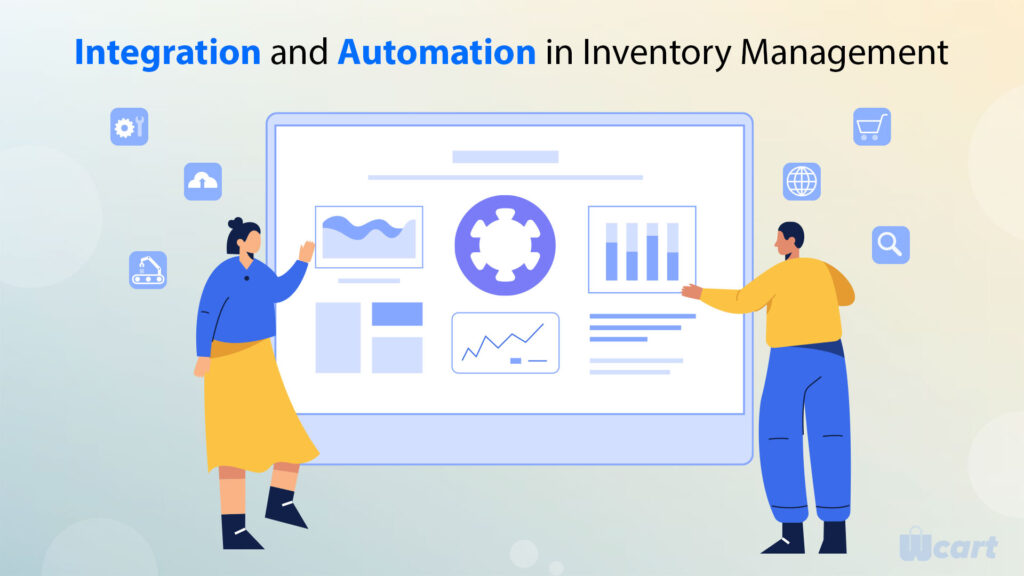
Integration and automation play crucial roles in optimizing inventory management processes in ecommerce. By integrating inventory management with other systems and leveraging automation tools, businesses can streamline operations, improve efficiency, and enhance overall business success.
Benefits of Integrating Inventory Management with Other Systems
Integrating inventory management with other systems, such as sales, order management, and accounting, offers several benefits:
a) Real-time Data Sync: Integration ensures that inventory data is synchronized across different systems, providing accurate and up-to-date information. This enables better decision-making and reduces the risk of errors caused by manual data entry.
b) Improved Efficiency: Integration eliminates the need for manual data transfer between systems, saving time and reducing administrative tasks. It facilitates seamless order processing, stock updates, and fulfillment, leading to improved operational efficiency.
c) Enhanced Visibility: Integrated systems provide comprehensive visibility into inventory levels, order statuses, and sales data. This visibility allows businesses to make informed decisions, optimize inventory levels, and meet customer demands effectively.
Automation Tools and Technologies for Inventory Management
Various automation tools and technologies can enhance inventory management in ecommerce:
a) Inventory Management Software: Dedicated inventory management software centralizes inventory data, streamlines processes, and automates tasks such as stock tracking, order fulfillment, and reordering.
b) Barcode and RFID Systems: Barcode and RFID (Radio Frequency Identification) technologies automate inventory tracking and improve accuracy in receiving, picking, and replenishing stock.
c) Demand Forecasting Tools: Automated demand forecasting tools use historical data, trends, and predictive algorithms to forecast future demand accurately. This aids in inventory planning and optimization.
Implementing Seamless Integration and Automation Solutions
To implement seamless integration and automation in inventory management, businesses can follow these steps:
a) Assess System Compatibility: Evaluate the compatibility of different systems and identify integration requirements. Choose solutions that offer seamless integration capabilities.
b) Select Suitable Automation Tools: Assess business needs and select automation tools that align with those needs. Consider features, scalability, and compatibility with existing systems.
c) Customize and Configure: Customize the integration and automation solutions to fit specific business processes and requirements. Configure data mappings, workflows, and rules to ensure seamless data flow and automation.
d) Test and Validate: Conduct thorough testing to validate the integration and automation processes. Identify and resolve any issues or errors before fully implementing the solutions.
e) Train and Educate Staff: Provide training and support to employees on using integrated systems and automation tools. Ensure that staff members understand the benefits and functionalities of the implemented solutions.
Strategies for Handling Seasonal and Promotional Fluctuations

Managing inventory during peak seasons and promotions requires specific strategies to meet increased demand and optimize inventory levels.
Challenges of Managing Inventory During Peak Seasons and Promotions
During peak seasons and promotions, businesses face unique challenges in inventory management:
a) Demand Volatility: Demand can fluctuate significantly during peak seasons and promotions, making accurate forecasting and planning challenging.
b) Stockouts and Overstocks: Balancing inventory levels to avoid stockouts while preventing excessive stock during off-peak periods requires careful management.
c) Supply Chain Pressures: Increased demand may put pressure on the supply chain, affecting lead times, logistics, and supplier capacities.
Techniques for Forecasting and Managing Seasonal Demand
To forecast and manage seasonal demand effectively, ecommerce businesses can adopt the following techniques:
a) Historical Data Analysis: Analyze past sales data during similar peak seasons or promotions to identify patterns and trends.
b) Collaborative Forecasting: Collaborate with suppliers, partners, and industry experts to gather insights and make more accurate demand forecasts.
c) Seasonal Promotions Planning: Plan promotions and marketing campaigns based on anticipated demand, taking into account historical data and market trends.
Implementing Effective Strategies to Optimize Inventory During Promotions
Effective strategies for optimizing inventory during promotional periods can greatly contribute to business success. In this section, we will explore key techniques that can help you efficiently manage your inventory and make the most of promotional opportunities.
Evaluating and Analyzing Inventory Performance

By regularly assessing key metrics such as stock levels, turnover rate, and profitability, you can gain valuable insights into the performance of your inventory and identify areas for improvement.
Key Performance Indicators (KPIs) for Inventory Management
KPIs play a vital role in measuring and tracking inventory management success. Some essential KPIs include inventory turnover ratio, carrying cost of inventory, stock-out rate, and order fulfillment time. These metrics provide valuable information about inventory efficiency, financial health, and customer satisfaction.
Tools and Techniques for Analyzing Inventory Performance
Inventory management software provides real-time data and reporting capabilities to monitor stock levels, track sales, and identify trends. Additionally, techniques like ABC analysis and cycle counting can help you classify and count inventory accurately.
Continuous Improvement and Optimization Strategies
Regularly reviewing and refining inventory processes, such as demand forecasting, replenishment planning, and supplier management, can lead to better inventory control and cost savings. Adopting lean principles and embracing automation can also drive efficiency and productivity.
Visit Here: Maximizing Profits with the Latest Ecommerce Trends
Best Practices for Inventory Loss Prevention

Inventory loss can significantly impact the profitability of an ecommerce business. Implementing best practices for inventory loss prevention is crucial to minimize theft, damage, and obsolescence. By following proper security measures, conducting regular audits, and implementing strict inventory control procedures, you can safeguard your inventory and reduce losses.
Common Causes of Inventory Loss in Ecommerce
Understanding the common causes of inventory loss is essential for effective prevention. Some typical causes include theft, shipping errors, inaccurate record-keeping, and product damage. Identifying these factors and addressing them through preventive measures and employee training can help mitigate inventory loss risks.
Preventive Measures and Security Systems
Implementing preventive measures and robust security systems can significantly reduce inventory loss. Measures such as installing surveillance cameras, implementing access controls, and conducting background checks on employees can act as deterrents and help identify and address potential risks promptly.
Implementing Loss Prevention Strategies
Implementing loss prevention strategies involves a combination of preventive measures, employee training, and ongoing monitoring. Regularly conducting physical inventory counts, implementing product labeling and tracking systems, and establishing clear inventory control policies and procedures can contribute to effective loss prevention in ecommerce.
Conclusion
Effective inventory management is a crucial factor in achieving business success in the ecommerce industry. By implementing essential techniques and following best practices, businesses can optimize their inventory processes, increase efficiency, and enhance customer satisfaction. For more queries, contact Wcart support team.
Frequently Asked Questions (FAQs)
What is the importance of inventory management in ecommerce?
Inventory management is crucial in ecommerce as it ensures that the right products are available at the right time to meet customer demand. It helps in reducing stockouts, optimizing storage space, and improving overall operational efficiency.
What are the key benefits of implementing effective inventory management techniques in ecommerce?
Benefits including improved order fulfillment, reduced holding costs, minimized stockouts, enhanced customer satisfaction, and increased profitability.
What are some common inventory management techniques used in ecommerce?
Common techniques include ABC analysis, just-in-time (JIT) inventory management, dropshipping, safety stock management, and demand forecasting. These techniques help in prioritizing products, minimizing excess inventory, and ensuring timely order fulfillment.
How does demand forecasting contribute to inventory management in ecommerce?
Helps in estimating future customer demand for products. By analyzing historical sales data, market trends, and other factors, ecommerce businesses can accurately predict the quantity of products they need to stock, minimizing the risk of overstocking or stockouts.
How can automation and technology aid in inventory management for ecommerce?
They enable real-time tracking of inventory levels, automatic reordering of products, integration with sales channels and suppliers, and accurate inventory data analysis. These tools help in streamlining operations, reducing manual errors, and ensuring efficient inventory management.




Leave a Reply